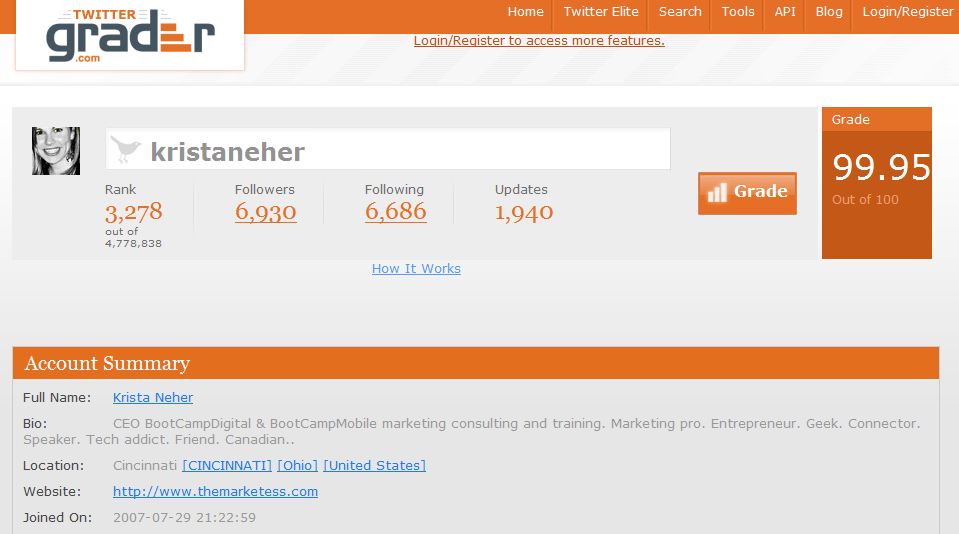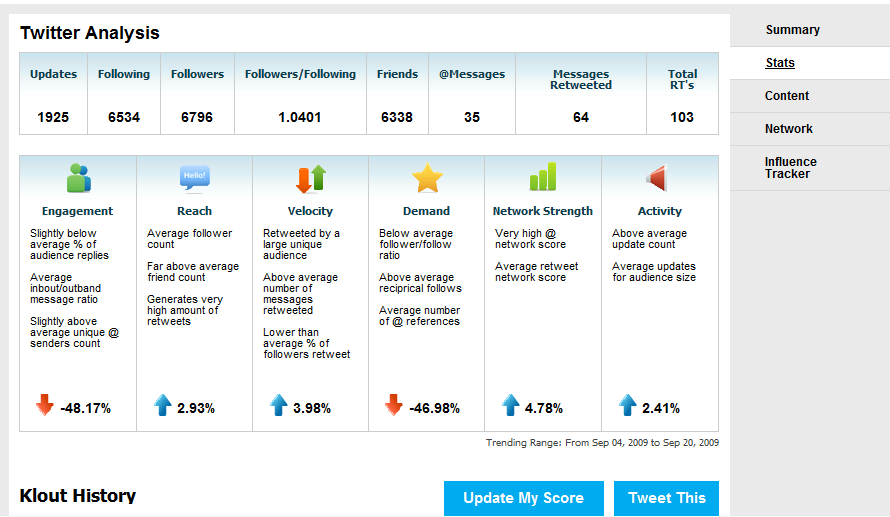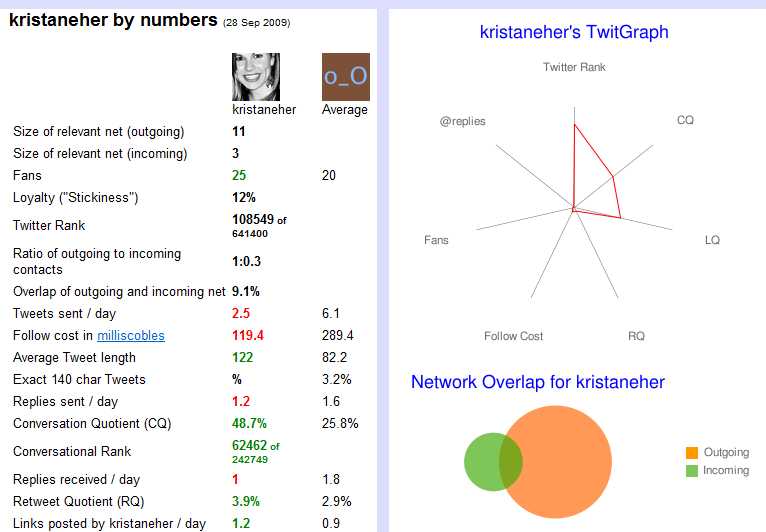21 Ways to Measure Your Twitter Account
Companies are flocking to twitter as it continues to grow, but many struggle with how to measure the effectiveness of their twitter campaigns.
Measurement continues to be an issue for twitter overall, but fortunately, there are a number of ways that you can measure how effective your twitter campaign is.
The same metrics aren’t right for every campaign – look at what your strategy is first and select the most important and relevant metrics as they relate to your objectives.
1. Number of Followers
This should never be your only metric since many people use tools like tweetdeck to selectively listen to only some of their followers. However it does give you a feel for the overall reach that you are getting out of your twitter account.
2. # of @ replies
Report on a weekly or monthly basis the # of @replies responding to your twitter account. This will help you understand how many people in your audience are actively engaging with you.
3. Number of RTs
The number of people re-tweeting you helps you to understand two things. First, how many people are actively following you (since they have to see your tweet to RT) and second, how engaging is your content. You can measure this with retweetrank. For further reading check out this extremely interesting article on the science of RTs.
4. Twitter Grader Score
Hubspot has a great tool called twittergrader. Twittergrader will score you based on how you stack up vs. other tweeters with the goal of calculating the kind of impact that you have on the twitterverse. The score and rank are based on 6 factors – # of followers, power of followers, updates, update recency, Follower/following ration and engagement.

5. Klout
Kloutis a product similar to twittergrader but on steroids. I am a bit of a quant-geek, and klout gives you tons of stats and analytics to help you track your twitter account. Klout provides you with specifics about how your account is trending and where you are above or below average. They definitely use more data in their algorithm and provide an interesting way to look at your twitter score.

6. Clicks on Links
Tracking the number of clicks that you are getting on links that you share can help you assess your influence and reach on twitter. By using a URL shortener link bit.ly or hootsuite you can actually track the # of clicks on your links.
7. Traffic to your Site
If you use on-site analytics like google analytics or wordpress stats on your website you should be able to see where your traffic comes from. Take a look at how much of your site traffic comes from twitter.
8. Tweet Tests
Set up specific twitter tests designed to measure the reach and influence of this tool. For example, you could have a twitter-only offer and based on the number of redemptions you would have a pretty clear idea of how strong your twitter network can be at driving sales. Dell Outlet has done over $2.5 million on twitter.
9. Number of Updates
By tracking your specific number of updates you’ll have an idea of how many people you are reaching and how often. This is a fairly base measure as it doesn’t account for the quality or effective reach of your tweets.
10. Sales
If you have an e-commerce site where you are selling something and a good stats package, you should be able to see how many sales you are actually converting from twitter.
11. Influencers who Follow you Back
If you are strategic about your social media efforts you should have a clear idea of who the key influencers in your space are. How many of them are following you back? Do they engage with you? All followers are not created equal – make sure that you are connecting with the ones that are most important for your business.
12. Follower/Following ratio
How many of your followers are you following back? Are you acquiring new followers simply by following new people (most people will reciprocate a follow and follow you back). This ratio helps you understand how many people actually want to be your friend and are actively following you vs. just returning a follow.
13. Brand Mentions Outside of Twitter
Use tools like google alerts or radian6 to measure your overall level of “buzz” online. Great executions on twitter result in people talking about your brand in other places online and offline.
14. Number of People Helped
How many people have you specifically solved a problem for via twitter? Many brands use twitter for customer service; often times you can get quicker responses from companies on twitter vs. via traditional methods. A simple monthly count of the # of issues resolved via twitter can tell you if this twitter is a relevant place for your audience.
15. Learning about Customer Issues
Your company probably has an email address or phone number where people can contact you to let you know about issues. You’d be surprised, however, by the number of people who prefer to vent publicly or post on twitter vs. contacting you directly. This is probably because a lot of customer service systems are time consuming and lack immediacy. By monitoring twitter you can often learn of issues before you would via traditional methods.
16. # of Passionate People
Building a passionate tribe of brand supporters is one of the most powerful things that you can do for your brand. If you nurture these relationships you’ll have an army of dedicated people who will jump to defend and promote your brand. You can’t buy this kind of support. How many truly passionate relationships is your brand building on twitter? Your community manager (or whoever manages your account) will know who these people are. They have high levels of interaction with your brand and they talk about your brand on multiple channels.
17. Number of Follow Friday Recommendations
Every Friday people on twitter recommend others to follow in an effort known as #FollowFriday (or FF). If you are getting a lot of FF recommendations it shows that people in your network trust you and recommend you to others. Check out topfollowfriday to see how many recommendations you have.
18. TwitterFriends
Twitterfriends gives you lots of valuable information about your network and influence. Their stats page can help you visualize your network and understand who you are connecting with. Some of their metrics seem a little sketchy, but their visualization tools will help you see if you are connecting with the influencers who really matter to you.

19. Twinfluence
Twinfluenceis yet another tool designed to help you understand your influence on twitter. Twinfluence gives you 3 scores: 1) reach, 2) velocity and 3) social capital. Tracking these metrics over time can help you understand if you are growing in these relevant areas.
20. Measure Total Online Sentiment and Mentions
There are a number of brand monitoring tools that help you measure your overall online mentions and sentiment. This will give you a more complete picture than just twitter and help you see the bigger picture. Some good tools to try include Radian6, webtrends social measurement or even something as simple as a google search. There are lots of brand and reputation monitoring tools that may be relevant depending on the size of your brand, amount of time and budget.
21. Twitalyzer
Twitalyzeris another twitter ranking tool. What makes this one powerful is that it will actually give you tips on how to improve your score. My scores on this tool were mostly “extremelylow” (probably because frequency is one of their key metrics vs. ratios).
What is the key to choosing the right metrics?
Start with your strategy and objectives for using twitter. From there you can focus on which metrics best measure those objectives. For example a twitter account with an aim of providing customer support will have a different set of measures than one hoping to drive direct sales on an e-commerce site.

Thank you for including us in your list monitoring tools. Great list for analyzing Twitter.
Lauren Vargas
Community Manager at Radian6
@VargasL
Thanks for stopping by – obviously your tool works pretty well 🙂
– Krista
Great post Krista (as always)! Thank you for not only listing the 21 ways but describing how to utilize them and including screen shots of some of the web-based tools. I’m going to go Tweet this!
I tend to block obvious spam followers, so that keeps my follower count down a bit compared with some others, but to me that’s OK. Any thoughts or advice on managing spam or “low value” followers?
Hi Rob
Thanks for the kind words 🙂
A few tools that you can use to manage spam on twitter (maybe this should be a blog post).
TweetLater.com (now social ooomph)allows you to “vet new followers” – this is a user friendly interface that shows you basic stats on the user as well as how many other people marked them as spam. You can also set guidelines (# of tweets, follower/following ratio, etc) and it will show you if new followers are green, yellow or red.
They also have a tool that manages DM SPAM – I don’t really know how well it works – I am afraid that it will blog legitimate messages.
Thanks for tweeting the blog post – much appreciated.
– Krista
Thanks for the post. Wow, I did not realize there’s so much ways to evaluate one’s Twitter account. 🙂 I just did it by checking the ratio of followers vs. followers and that’s pretty much it. Using the tools you can really study someone’s account (or profile) and see how to proceed. The post goes right to my bookmarks.:)
Book Reviews »
Time to Reset and Get Back to What Drives Success: The Compound Effect
On my way to DC to speak to a group on Capitol Hill over the summer I was reading a book called The Compound Effect. I read lots of different books and usually get a …
Branding »
Show Don’t Tell: Good Marketing Isn’t about Irrelevant Messages
As you probably know, I live in Cincinnati, and the Cincinnati airport CVG has had the highest fares in the nation. Yes, the most expensive airport to fly from in America has been Cincinnati, an …
News & General »
What to do AT the Conference: Rocking SXSW and PubCon
In my last post I shared tips about what to do in preparation for a conference. Planning who to meet, knowing what you want to achieve and doing your research. In this post I want …
Social Media »
Are You in the Business of Getting Likes on Facebook?
No. You are in the business of what you actually do…. designing sneakers, selling soap or offering accounting services. Whatever business your in, that is what you actually do. Unless you are in the business of …
Start-up & Small Biz »
Competition vs. Cooperation? How do you view your Business?
This is a blog post that I’ve been thinking about writing for a while now. I’ve been running my own business for over 2 years now, before that I worked for a cash-strapped Internet Start-up …
Archive
Blogroll
Tag Cloud
ad:tech adclub adclub cincinnati adtechny advertising beginners Blogging blogs brand building brand equity Branding brands cincinnati communication conference conversational marketing digital hub digital marketing facebook interactive marketing jetblue Krista Krista Neher linked in LinkedIn marketing Marketing Book Review marketing with meaning mobile marketing news non-conference online marketing PR ROI SES chicago small business Social Media social media marketing spam speaking startup twitter viral marketing word of mouth zapposRandom Posts
Latest Video Post
Recent Comments
Recent Posts
Most Popular